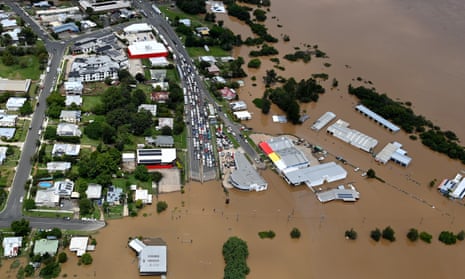Banks expect to reduce lending to households and businesses in northern Australia and to fossil fuel industries across the country as the risk of losses due to the climate crisis escalates, the industry regulator says.
A new report by the Australian Prudential Regulation Authority (Apra) found climate change could make banks more vulnerable to economic downturns as they face up to a threefold increase in lending losses by 2050, but that the system should be able to absorb the impact.
The climate vulnerability assessment (CVA) said banks’ lending losses on mortgages were expected to be higher in parts of northern Australia, which is at greater risk of extreme weather events including cyclones and heavy rain. Modelling from the banks suggested lending losses in Queensland could increase by 35% between 2030 and 2045.
Lending losses from businesses were expected to be higher in fields most affected by the transition to a net zero emissions economy, including mining, manufacturing and transport.
The assessment found the country’s five biggest banks – ANZ, Commonwealth Bank, Macquarie, NAB and Westpac – were likely to respond to the potential for higher lending losses by tightening loan-to-value ratio limits on new mortgages and reducing lending to regions and economic sectors most at risk unless there was additional government policy support.
Observers said the assessment was a good start in considering climate risk on banks, but did not go far enough in assessing the impact on all parts of the economy, or the cumulative effect of extreme events and rising temperatures.
Erwin Jackson, policy director with the Investor Group on Climate Change, which represents $2tn in assets under management, said there was a lot of variability in the results from different banks, in part because the models were new and the data incomplete.
“The government needs to increase funding for the underlying climate science, and the banks need to significantly improve their analysis that translates the science into comprehensive climate risk models,” he said.
Jackson said the assessment showed banks were changing their lending practices. “That means pulling back from banking vulnerable industries and regions,” he said. “Investors are also undertaking similar approaches in response to climate risks.”
after newsletter promotion
He said investors had the capital ready to fund climate solutions, but to allocate capital with confidence they needed a reliable picture of the risks and opportunities. Which he said requires companies produce and release information on climate risk, and strong government policy to adapt to the impacts of climate change and drive an orderly transition to net zero.
Apra’s deputy chair, Helen Rowell, said the assessment was an important step as it required the banks to develop techniques in climate analysis, but there were limitations, such as banks using different modelling approaches and assumptions.
“Despite the high profile of climate change, climate risk management and modelling remain emerging areas of expertise, in part due to uncertainty about how the risks will play out decades into the future, and how these risks are incorporated into financial models,” she said.
“This, however, is a good start and we urge all Apra-regulated entities to examine the CVA findings to see how they can leverage the insights to enhance their own climate risk analysis and management.”
The treasurer, Jim Chalmers, said the report was “a really significant contribution to understanding the risks of climate change in our banking system”.
The government is developing a framework for climate disclosure by businesses and financial institutions. A consultation paper is expected next month.
